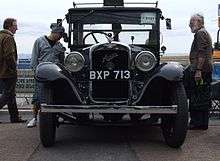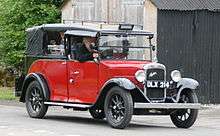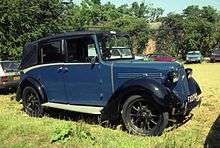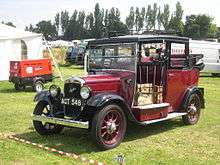Austin London Taxicab
The Austin London Taxicab used a modified Austin Heavy Twelve-Four chassis clothed with new bodies designed by London's largest taxicab retailer and dealer Mann & Overton, and made for Mann & Overton by London coachbuilders. From 1930 to 1934 this first Austin London taxicab was colloquially known as the High Lot or Upright Grand. On a new chassis and thereby much lowered its appearance was revised in 1934 and it was renamed by Austin the Low Loading taxi.[1]
Previously Austin had only provided hire car chassis not troubling to make major amendments to that chassis to comply with Metropolitan Police regulations for London taxicabs.[2]

| Austin Twelve engine 4 | |
|---|---|
| Overview | |
| Manufacturer | Austin |
| Combustion chamber | |
| Configuration | Straight 4-cylinder[3] |
| Displacement | 1,861 cc (114 cu in)[3] |
| Cylinder bore | 72 mm (2.8 in)[3] |
| Piston stroke | 114.5 mm (4.51 in)[3] |
| Cylinder block alloy | cast iron, alloy crankcase. The inlet manifold is cast in one with the cylinder head[3] |
| Cylinder head alloy | detachable, pistons are aluminium[3] |
| Valvetrain | side-by-side valves, tappet covers may be easily removed, timing is driven by chain[3] |
| Combustion | |
| Fuel system | single carburettor supplied by a vacuum tank which draws from a reservoir beneath the driver's seat, ignition by magneto driven by chain placed behind the timing, dynamo driven by same chain[3] |
| Fuel type | petrol[3] |
| Oil system | lubrication by forced feed, filler on the offside[3] |
| Cooling system | radiator, fan, cooling water is circulated by a pump forward of the timing on the nearside[3] |
| Output | |
| Power output |
27 bhp (20 kW; 27 PS) @2,000 rpm Tax horsepower 12.8[3] |
| Chronology | |
| Predecessor | new |
| Successor | Austin Twelve |
History
Will Overton, director of the car dealership Mann & Overton, had been selling Unic taxicabs in London since 1906. In 1924 their business with its French-made Unics had provided almost 80% of the new taxicabs bought in London. In 1925, with effect from 1 May 1926, McKenna duties were imposed on commercial vehicles to protect UK manufacturers from imports and in spite of Unic's local assembly operation in Cricklewood which opened in 1928 it was no longer possible to supply London with French Unic taxicabs at an acceptable price. So William Overton approached Herbert Austin about modifying the Heavy Twelve-Four hire car chassis so that it would comply with the London Conditions of Fitness. It had been announced in 1927 that those regulations would be lightened with effect in 1928. In view of the easing of the Police regulations and the enormous gap in the market left by imported vehicles Austin duly modified their hire car chassis to suit and Mann & Overton arranged for their catalogued three standard bodies made in Greater London by: Strachan or Vincent or—for £5 more—Jones.
High Lot
Because the overall height of the 1930 version[note 1] was much greater than the competition it received the nickname High Lot or Upright Grand. This design gave top hat wearing customers plenty of room. It was soon outselling the Beardmore and Morris-Commercial versions.
Low Loading
Their new Low Loading (LL) taxicab was introduced in 1934 with an overall height some 7 inches lower arranged by using the redesigned back axle (the final drive was switched from overhead to underslung) and dropped cross-braced frame introduced by Austin for their new Light Twelve-Four and Light Twelve-Six cars.
Standard equipment included luxuriously upholstered Standard Cab Landaulette body, cellulose blue with full windscreen, and both front and rear bumpers. Fire extinguisher, horn, number plates, license holder, taxi sign, Trico visional wiper and speedometer were also included.
All exterior fittings were chromium plated. The list price was GB£395. Hire purchase terms were £50 deposit with monthly installments of £10, for a total price of £472, or £18 less if purchased completed in 40 months (rebate reduced by £3 for each additional month.)
Flash Lot
There was one more variant before the outbreak of war, both grille and windscreen were raked, the grille and the wings (mudguards) were flared and matched those of the Austin Twelve saloon introduced in 1934. Few were made before the outbreak of war ended manufacture. These taxicabs proved to be the last with a landaulette body which was forbidden by new regulations issued soon after the war.
- Austin 12 Taxicabs 1930—1939
-

High Lot
or Upright Grand
1933 by Vincent of Reading -

Low Loading
body by Strachan of Acton 1937 -

Flash Lot
body by Jones Bros of Bayswater 1939
- Carriage of passengers' luggage
-

High Lot
or Upright Grand -

Low Loading
body by Jones Bros
Replacement
After World War II, Mann & Overton decided that it needed a more up-to-date design. So it was agreed that Austin would supply the engine/chassis with the body supplied by Carbodies in Coventry, although the body was actually designed by Austin's chief body designer Jim Stanfield. In 1948 a new Austin taxi appeared on the streets called the FX3. It was soon the market leader. Although in 1952 a diesel engine from Perkins Engines was available as a conversion, by 1954 Austin was producing their own 2.2 litre diesel engine as a factory fit. Also made by Austin and Carbodies was the hire car FL1 which was almost identical but it had no luggage space by the driver having instead a bench seat and there was no roof sign.
See also
Note
- ↑ A New Taxicab
Austin Twelve for London Next Month
Scotland Yard has approved another new taxicab which, it is expected, will appear in the streets of London next month. This is an Austin Twelve which will embody all the latest features of taxicab comfort . . . unsplinterable glass will be a standard fitting.
News in Brief. The Times, Thursday, Apr 03, 1930; pg. 14; Issue 45478
References
External links
| Wikimedia Commons has media related to Austin 12 Taxicab. |
- Handbook of the Austin 12 h.p. Taxi, Publication no. 1384, Price One Shilling
- Austin Taxi by Austin Memories
| Austin Motor Company road car timeline | ||||||||||||||||||||||||||||||||||
|---|---|---|---|---|---|---|---|---|---|---|---|---|---|---|---|---|---|---|---|---|---|---|---|---|---|---|---|---|---|---|---|---|---|---|
| Type | 1900s | 1910s | 1920s | 1930s | ||||||||||||||||||||||||||||||
| 6 | 7 | 8 | 9 | 0 | 1 | 2 | 3 | 4 | 5 | 6 | 7 | 8 | 9 | 0 | 1 | 2 | 3 | 4 | 5 | 6 | 7 | 8 | 9 | 0 | 1 | 2 | 3 | 4 | 5 | 6 | 7 | 8 | 9 | |
| Small family car | 7 hp | Seven | ||||||||||||||||||||||||||||||||
| Eight | ||||||||||||||||||||||||||||||||||
| 10 hp | Ten | |||||||||||||||||||||||||||||||||
| Family car | ||||||||||||||||||||||||||||||||||
| 12-14 | Twelve | Light Twelve | ||||||||||||||||||||||||||||||||
| Heavy Twelve | ||||||||||||||||||||||||||||||||||
| Twelve-six | Fourteen | |||||||||||||||||||||||||||||||||
| Full-size car | 15 hp | Sixteen or Eighteen | Eighteen | |||||||||||||||||||||||||||||||
| 20 hp | Twenty | Twenty-Eight | ||||||||||||||||||||||||||||||||
| 15-20 | 18-24 | |||||||||||||||||||||||||||||||||
| 30 hp | ||||||||||||||||||||||||||||||||||
| 25-30 | 40 hp | |||||||||||||||||||||||||||||||||
| 50 hp | ||||||||||||||||||||||||||||||||||
| 60 hp | ||||||||||||||||||||||||||||||||||
| Coupé / Roadster | ||||||||||||||||||||||||||||||||||
| Taxi | Austin Twelve Top Hat |
Austin Twelve Low Loader | ||||||||||||||||||||||||||||||||